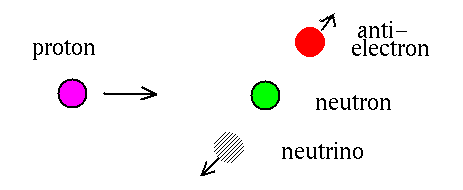Solar neutrinos
As we have seen, the evidence is strong
that the overall reaction is "burning" hydrogen to make helium:
4 1H + 2 e --> 4He + 2 neutrinos + 6 photons
In this reaction, the final particles have less internal energy than
the starting particles. Since energy is conserved, the extra energy is
released as energy of motion of the nuclei in the solar
gas and the production of lots of photons and, finally, the
energy of the neutrinos. That is
the gas gets hotter and has lots of photons. The neutrinos just zip right out of the Sun. The amount
of energy involved is
26 MeV = 4.3 × 10‒12 J
for each time the reaction above happens.
For each reaction, two neutrinos are made. The number is 2 because
to turn 4 protons into 2 protons + 2 neutrons (a 4He) we
need to change 2 protons into neutrons using the weak interaction.

If the current standard picture of neutrinos is right, then
these neutrinos just zip through the Sun and are radiated into
space. Eight minutes after they are emitted, they pass through the earth.
We can estimate the flux of neutrinos on earth, that is the number of neutrinos that, each second, pass through a 1 square meter surface perpendicular to the direction to the sun. This number is the amount of energy per unit area per unit time that we get from the sun times the number of neutrinos per unit of energy released
F = N/(A t) = E/(A t) × N/E
= 1.4 × 103 J m‒2 s‒1
× 2/(4.3 × 10‒12 J)
= 6.5 × 1014 m‒2 s‒1
That seems like quite a lot. It amounts to about two neutrinos per square cm in the room now, all moving away from the sun at the speed of light or close to it.
We should test this idea if we can.
Some things to know about neutrinos
- There are actually three kinds of neutrinos: the electron neutrino, the muon neutrino, and the tau neutrino.
- These are matched with the three kinds of electron-like particles that we know about: the electron, the muon, and the tau. (The muon and the tau are like the electron, but heavier.)
- The neutrinos created in nuclear reactions in the sun are electron neutrinos.
- The standard model of particle physics allows for the weird possibility that each of the three types of neutrino can "oscillate" to appear as one of the other types. (This is a feature of quantum mechanics.)
- This possibility requires that the neutrinos have non-zero masses.
- Direct attempts to measure the neutrino masses show that the the masses are either zero or are non-zero but below the limit of detection.
Some things to know about solar neutrinos
- The neutrinos made in the main energy producing reaction have rather low energy.
- Some higher energy neutrinos are made in less common reactions in the sun.
Some things to know about neutrino interactions
- Mostly, neutrinos don't interact.
- They can cause nuclear reactions like
37Cl + neutrino --> 37Ar + electron
Here the argon nucleus is unstable and will decay back into clorine with a half life of a few days.
- A neutrino can also hit an electron and some of its transfer energy to the electron. If the electron is in water, the fast moving electron radiates visible-light photons that can be detected.
Some experiments
ASTR 122 course home page
Updated 22 Octobber 2007
Davison E. Soper, Institute of Theoretical Science,
University of Oregon, Eugene OR 97403 USA

